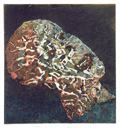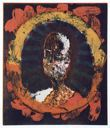Felix Martin Furtwängler
German
(Karlsruhe, Germany, 1954 - )
Felix Martin Furtwängler was born in Karlsruhe, Germany in 1954.(1) From childhood his interests were widely varied, and after he graduated from high school, he studied a number of different forms of design and graphic arts before settling on a career as a fine artist and printer. Beginning in 1972, he studied commercial graphics at the Kunstschule Alsterdamm (Alsterdamm Art School) in Hamburg and the Schule für Werkkunst und Mode (School for Art and Fashion) in Berlin. In 1975, he began taking classes in industrial product design at the Hochschule der Künste (Academy of Art) in Berlin, and participated in a practicum on mechanical engineering in his native Karlsruhe.
In 1977, Furtwängler opened his own small print shop near Ettlingen, Germany called Selbstverlag Feldweg. The following year he produced his first book, Niemands Traum (Nobody's Dream), and also published his first art-books in cooperation with the printer, Martin Schäfer. In late 1982, Furtwängler moved to the rural area of Forst near Zedtwitz, Germany and renamed his print shop Forster Presse, continuing to produce small editions of his own prints and printed books. When he returned to Berlin three years later, he changed the name of the press to Tyslander Pres.
During the years that he ran his press, Furtwängler also began to seriously pursue a career in art.(2) He continued to take classes at the Hochschule der Künste, switching from industrial product design to the program in painting and graphics. He supplemented his coursework with workshops, such as a Master Class in painting under Gerhart Bergmann in 1983. In 1990, as an outgrowth of his printed books, he began producing large-format sculptural book objects and painted books, and in 1992, he won the Lucas Cranach Prize for his painting, Prophets of Decay, which created a larger audience for his work.
Furtwängler has worked primarily as a freelance artist since 1982 producing paintings, etchings, woodcuts, linocuts, collages, handmade books, and sculptural book-objects. In addition, he has served as editor and printer of his own graphic cycles and art-books since 1976. Furtwängler has produced more than 50 books, most in small editions of 10 or less. Seven other books have been published by companies other than his own press.(3) His largest project, the Tagebuch der Angst (Diary of Fear), was begun in 1978. Furtwängler envisioned the Tagebuch as a visual diary of his times and originally tried to produce a woodcut for it each day. He continues to work on the project sporadically, and has so far produced over 400 related woodcuts, including both individual works and cycles of prints.
Furtwängler began participating in exhibitions in 1979, and has had at least one show a year since 1989. Most of these have been solo exhibitions and have taken place at German galleries, particularly in Berlin. Two of the most notable exhibitions were a large-scale show of his work at the Klingspor Museum in Offenbach in 1985, and a show of his handmade books at the Frankfurter Museum für Kunsthandwerk in 1989. Furtwängler's works can be found in the collections of the Staatliche Museum in Berlin, Staatliche Kunstsammlungen in Dresden, the Museum für Kunsthandwerk in Frankfurt, the Los Angeles County Museum of Art, the Newark Public Library, Yale University Art Gallery, and the M. H. de Young Memorial Museum, among others.
Furtwängler rarely plans his paintings and drawings, preferring to spontaneously create and then rework them, but his prints are usually carefully planned through preliminary studies. Furtwängler's works are generally built up in layers including, sometimes, layers of different media such as painting over printing, or collage over painting. His "book-objects" combine sculpture, writing, painting, and printmaking.(4) Part of the layering in Furtwängler's work also stems from his constant revisions which he leaves visible and incorporates into the larger composition. In many works, the process of creation and revision replaces the subject as the focus of the work.
One of Furtwängler's principal interests is the relationship between pictures and text. He frequently combines words and images, particularly in his prints, often cutting text into the wood block along with the rest of the design or overprinting text onto a finished image. In some works, the text pages are entirely etched or cut rather than typeset. Furtwängler uses a combination of his own writings and those of expressionist authors such as Max Beckmann, Gottfried Benn, and August Stramm to accompany, and sometimes interpret, his images.
Furtwangler's work has been most strongly influenced by that of the German Expressionists such as Ernst Kirchner and Max Beckmann, with whom he claims a close kinship. As well, his work contains many elements common to the Dada Group, most notably irony and cynicism, and the use of fragments of modern culture to comment on the ills of society.(5) Other critics have suggested such diverse influences as the works of Francisco Goya, Otto Dix, and David Alfaro Siqueiros.(6) Furtwängler's work often employs and explores duality, contrasting tragedy and comedy, hope and devastation, myth and reality, and suggesting double meanings. Furtwängler addresses these issues through the use of traditional Western symbolism as well as his own symbolic language. His most constant themes, however, are loss(7) and the perils of modern life.
(1)Biographical information has been compiled from the following sources: artist's vitae; Felix M. Furtwängler, Notzeichen, Städtische Galerie, Bietigheim-Bissingen, 1993; Felix M. Furtwängler, A Utopia: Malerei, Graphik, Buchobjekte, Museum Schloss Burgk, 1994; Felix Martin Furtwängler, Ortslosigkeit: Malerei, Radierung, Objekte, Scharpf Galerie des Wilhelm Hack Museums, 1995. Translations of Ortslosigkeit and A Utopia were provided by the artist. (2)During his first few years in Berlin, Furtwängler chose to work under the pseudonym, O. W. Solman. (3)The largest stock of Furtwängler's graphic work (over 500 pieces) is currently at the Veste Coburg Kupferstichkabinett. (4)As of 2/28/97, information on Furtwängler's cast books is available to members of America Online at: members-aol.com@fmalbrecht/everlag.htm. (5)A Utopia, 1994, p. 46. (6)Ortslosigkeit, 1995, p. 7. (7)Ortslosigkeit, 1995, p. 12.
M. Bullock 3/24/97
German
(Karlsruhe, Germany, 1954 - )
Felix Martin Furtwängler was born in Karlsruhe, Germany in 1954.(1) From childhood his interests were widely varied, and after he graduated from high school, he studied a number of different forms of design and graphic arts before settling on a career as a fine artist and printer. Beginning in 1972, he studied commercial graphics at the Kunstschule Alsterdamm (Alsterdamm Art School) in Hamburg and the Schule für Werkkunst und Mode (School for Art and Fashion) in Berlin. In 1975, he began taking classes in industrial product design at the Hochschule der Künste (Academy of Art) in Berlin, and participated in a practicum on mechanical engineering in his native Karlsruhe.
In 1977, Furtwängler opened his own small print shop near Ettlingen, Germany called Selbstverlag Feldweg. The following year he produced his first book, Niemands Traum (Nobody's Dream), and also published his first art-books in cooperation with the printer, Martin Schäfer. In late 1982, Furtwängler moved to the rural area of Forst near Zedtwitz, Germany and renamed his print shop Forster Presse, continuing to produce small editions of his own prints and printed books. When he returned to Berlin three years later, he changed the name of the press to Tyslander Pres.
During the years that he ran his press, Furtwängler also began to seriously pursue a career in art.(2) He continued to take classes at the Hochschule der Künste, switching from industrial product design to the program in painting and graphics. He supplemented his coursework with workshops, such as a Master Class in painting under Gerhart Bergmann in 1983. In 1990, as an outgrowth of his printed books, he began producing large-format sculptural book objects and painted books, and in 1992, he won the Lucas Cranach Prize for his painting, Prophets of Decay, which created a larger audience for his work.
Furtwängler has worked primarily as a freelance artist since 1982 producing paintings, etchings, woodcuts, linocuts, collages, handmade books, and sculptural book-objects. In addition, he has served as editor and printer of his own graphic cycles and art-books since 1976. Furtwängler has produced more than 50 books, most in small editions of 10 or less. Seven other books have been published by companies other than his own press.(3) His largest project, the Tagebuch der Angst (Diary of Fear), was begun in 1978. Furtwängler envisioned the Tagebuch as a visual diary of his times and originally tried to produce a woodcut for it each day. He continues to work on the project sporadically, and has so far produced over 400 related woodcuts, including both individual works and cycles of prints.
Furtwängler began participating in exhibitions in 1979, and has had at least one show a year since 1989. Most of these have been solo exhibitions and have taken place at German galleries, particularly in Berlin. Two of the most notable exhibitions were a large-scale show of his work at the Klingspor Museum in Offenbach in 1985, and a show of his handmade books at the Frankfurter Museum für Kunsthandwerk in 1989. Furtwängler's works can be found in the collections of the Staatliche Museum in Berlin, Staatliche Kunstsammlungen in Dresden, the Museum für Kunsthandwerk in Frankfurt, the Los Angeles County Museum of Art, the Newark Public Library, Yale University Art Gallery, and the M. H. de Young Memorial Museum, among others.
Furtwängler rarely plans his paintings and drawings, preferring to spontaneously create and then rework them, but his prints are usually carefully planned through preliminary studies. Furtwängler's works are generally built up in layers including, sometimes, layers of different media such as painting over printing, or collage over painting. His "book-objects" combine sculpture, writing, painting, and printmaking.(4) Part of the layering in Furtwängler's work also stems from his constant revisions which he leaves visible and incorporates into the larger composition. In many works, the process of creation and revision replaces the subject as the focus of the work.
One of Furtwängler's principal interests is the relationship between pictures and text. He frequently combines words and images, particularly in his prints, often cutting text into the wood block along with the rest of the design or overprinting text onto a finished image. In some works, the text pages are entirely etched or cut rather than typeset. Furtwängler uses a combination of his own writings and those of expressionist authors such as Max Beckmann, Gottfried Benn, and August Stramm to accompany, and sometimes interpret, his images.
Furtwangler's work has been most strongly influenced by that of the German Expressionists such as Ernst Kirchner and Max Beckmann, with whom he claims a close kinship. As well, his work contains many elements common to the Dada Group, most notably irony and cynicism, and the use of fragments of modern culture to comment on the ills of society.(5) Other critics have suggested such diverse influences as the works of Francisco Goya, Otto Dix, and David Alfaro Siqueiros.(6) Furtwängler's work often employs and explores duality, contrasting tragedy and comedy, hope and devastation, myth and reality, and suggesting double meanings. Furtwängler addresses these issues through the use of traditional Western symbolism as well as his own symbolic language. His most constant themes, however, are loss(7) and the perils of modern life.
(1)Biographical information has been compiled from the following sources: artist's vitae; Felix M. Furtwängler, Notzeichen, Städtische Galerie, Bietigheim-Bissingen, 1993; Felix M. Furtwängler, A Utopia: Malerei, Graphik, Buchobjekte, Museum Schloss Burgk, 1994; Felix Martin Furtwängler, Ortslosigkeit: Malerei, Radierung, Objekte, Scharpf Galerie des Wilhelm Hack Museums, 1995. Translations of Ortslosigkeit and A Utopia were provided by the artist. (2)During his first few years in Berlin, Furtwängler chose to work under the pseudonym, O. W. Solman. (3)The largest stock of Furtwängler's graphic work (over 500 pieces) is currently at the Veste Coburg Kupferstichkabinett. (4)As of 2/28/97, information on Furtwängler's cast books is available to members of America Online at: members-aol.com@fmalbrecht/everlag.htm. (5)A Utopia, 1994, p. 46. (6)Ortslosigkeit, 1995, p. 7. (7)Ortslosigkeit, 1995, p. 12.
M. Bullock 3/24/97
Artist Objects







